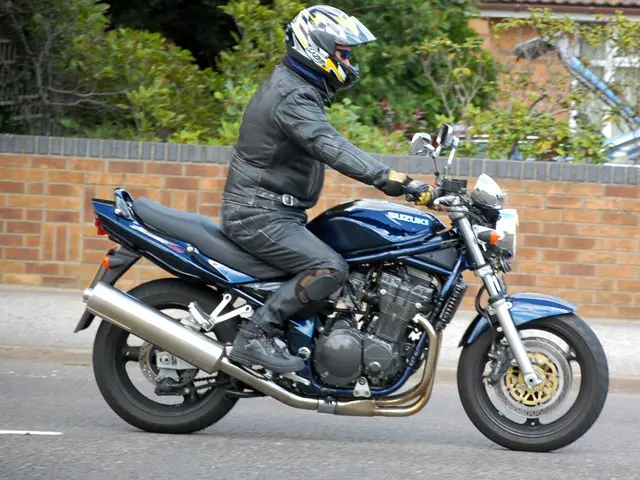Learning About Vertical Videos: Definition, Tips, and Illustrations
Alright, buckle up and get ready to dive into the world of vertical videos! If you've been on social media, you've probably stumbled upon them before - that's right, those awkwardly tall pieces of content that fill your phone screen. But there's a method to this madness – stay with me, and I'll explain why you should consider climbing aboard this trend.
Picture this: You're scrolling through your social media feed, minding your own business, when all of a sudden, a video catches your eye. You didn't expect it to be that tall, but it fits nice and cozy onto your phone screen. Unlike their horizontal counterparts, these vertical videos come in a 9:16 aspect ratio and are tailored to the mobile experience. They've been making the rounds on TikTok, Instagram stories, and Snapchat, to name a few, and it seems like video marketing services and content creators can't ignore them any longer.
So here's why you should hop on the vertical video bandwagon:
- Social Media Favorites: When the cool kids start doing something, the rest of us want to jump in on the action. Major social media platforms have embraced this trend, and their algorithms reward content that caters to what their users prefer. Audiences have grown accustomed to watching vertical videos because, hello, that's how they naturally hold their phones.
- Natural User Experience: With over 75% of all videos played on mobile devices, it's no wonder people gravitate toward vertical videos. They're easier to watch and more comfortable – you don't have to adjust your grip or awkwardly tilt your screen every time you want to watch a video. Plus, both live-action and animation companies prioritize mobile optimization.
- Improved Completion Rates: Let's face it, audiences have short attention spans. It can be tough to get them to watch a video all the way through sometimes. But guess what? Vertical videos have been found to have a staggering 90% completion rate compared to their horizontal counterparts. Maybe it's because the limited details in the frame make it easier to focus on the content, or perhaps it's just more convenient, but either way, they help increase the chances that viewers will stick around to see your message.
- Attention Seekers: In a crowded social media feed filled with various media formats, vertical videos stand out like a sore thumb – or should I say, a tall one? They catch the viewer's eye and demand attention thanks to their unusual aspect ratio and full-screen display. This makes them an effective tool for marketers and content creators who want their messages to break through the noise.
- Easy Peasy Lemon Squeezy: Creating vertical videos is the epitome of accessibility. Since smartphones are naturally held vertically, shooting videos in this format is a breeze. Users don't need any additional equipment or need to adjust their grip, making it a cinch for anyone with a smartphone to create videos.
Now that I've got you on board, I'll fill you in on a little more jargon you'll need to know: The vertical aspect ratio is that relationship between a video's width and height when the video is taller than it's wide. The most common aspect ratios are 9:16 and 4:5.
A 9:16 ratio is the Holy Grail on Snapchat, Instagram Stories, TikTok, and Facebook Stories. This aspect ratio ensures that videos take up the entire screen when a smartphone is held upright, offering an immersive viewing experience that fills the user's field of vision.
The 4:5 ratio is ideal for Instagram posts and some advertisements because it's slightly less tall than 9:16 but still offers a vertical view. It doesn't take up the entire screen, but it captures significant visual space, balancing attention with space for on-screen interactions.
As for resolution, the most common ones include Full HD, HD, and pixel sizes optimized for Instagram, Stories, and smartphones with high-resolution screens. If you want to create a vertical video but aren't sure where to start, there are tools available like Adobe Premiere Pro, InShot, and Kapwing to help you out.
Now, let's talk strategy: For Instagram Stories & Reels, embrace that full-screen vertical format to create an immersive viewing experience, keeping in mind a 9:16 aspect ratio and a recommended resolution of 1080 x 1920 pixels. On the other hand, for Instagram feed videos, a 4:5 aspect ratio is more popular and will take up more screen space without covering the entire screen.
Remember, each social media platform has its own unique requirements and best practices. TikTok, for instance, prefers that content fills the entire screen in portrait orientation, so sticking with a 9:16 aspect ratio is best here. On the flip side, on Facebook Stories, opt for a 9:16 aspect ratio and a resolution of 1080 x 1920 pixels for an immersive, full-screen experience.
But when should you use horizontal videos instead? Horizontal videos are best suited for long-form content like educational videos, vlogs, and documentaries, as they offer a wider field of view and are easier to repurpose across multiple platforms.
In conclusion, vertical videos are the key to unlocking the huge potential offered by mobile-first platforms, short-form content, and social media ads. Vertical videos not only align with mobile behaviors but also improve the reach and impact of video content by embracing the user experience on popular platforms. So, when in Rome (or on social media), do as the Romans do and go vertical!
- As you scroll through social media, you might notice a growing trend where vertical videos catch your eye, fitting perfectly onto your phone screen in a 9:16 aspect ratio that caters to mobile experiences.
- Integrating technology in the form of vertical videos into your lifestyle can offer benefits such as improved completion rates, easy creation, and increased attention on social media platforms, making them an effective tool for marketers and content creators.








